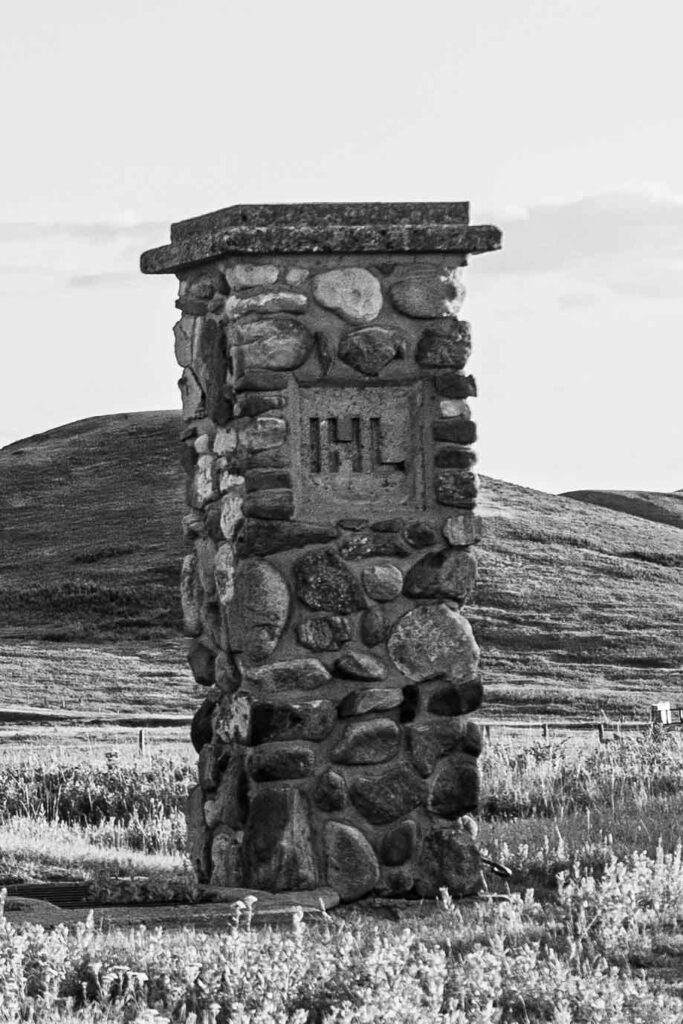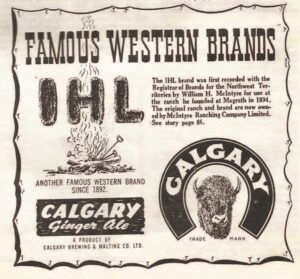
Mr. Charles A. Magrath, who was a Dominion land surveyor and in charge of land sales for the Alberta Railway and Irrigation Company, sold the first tract of land to my father in 1894. My father placed a great deal of confidence in Mr. Magrath and often spoke of him as being a second George Washington, which was the best compliment he could possibly give anyone, because George Washington occupied first place among all of the great men of whom he had heard. Mr. Magrath became the first Mayor of Lethbridge, Speaker of the North West Territories Legislature at Regina, Member of the Dominion Parliament, Chairman of the Canadian Section International Joint Commission, and Chairman of the Ontario Hydro Electric Commission. He now resides at Victoria, B. C.
(To Be Continued)
Tuesday, August 19, 1947
The location of the home ranch site was made by my father at the very foot of the Milk River Ridge on a fairly level and smooth spot between the two branches of the Pot Hole Creek – West Pot Hole and East Pot Hole. At this location there was a nice spring of water which rose at an elevation sufficiently high to permit its being piped to ranch buildings. Also, coal indications were seen in the burrowings of gophers and badgers, and as a consequence of this, a few years later, a tunnel was driven into the side of Milk River Ridge and a one man coal mine began operations. The Pot Hole Creek flowed a considerable stream of water during the spring freshet season, coming from melting snow, and also after periods of heavy rainfall, but much of the year it was a dry creek bed in which numerous rather deep holes held water for much of the year. Because of these numerous holes in the creek bed it got its name of Pot Hole Creek.
Logs were hauled from the mountains about 60 miles west of the ranch site and a couple of two-roomed log ranch houses, a one-roomed log bunk house, a small log horse barn and a pole corral were erected. The two-roomed ranch house was added to room by room as the years went by until it finally became an eight-room house – each room having an outside door, with tree rooms being heated by small stoves and the other rooms having no heat.
A small herd of purebred, black Galloway cattle and some Shorthorn cows and bulls were shipped in by rail from Utah. Horses were trailed overland from Utah and some purebred Shire mares and several stallions were shipped in from Utah by rail. Dogie cattle were shipped in from Manitoba and Oregon under contract, and, if my memory serves me rightly, the late Lester Ironsides of Winnipeg had a big hand in supplying the dogie cattle. Mr. A. C. Cunningham of Salt Lake City made an agreement with my father to run cattle with my father on this newly acquired property, and had made a start at doing so by sending a small bunch of cattle and a few horses to the ranch. After the experience of a couple of winters, he decided that he did not want any more of it and sold his interests to my father and then acquired a ranch in Old Mexico, which was later taken away from him by the Bandit Leader, Pancho Villa.

My father’s cattle brand in Utah had been on the left ribs. For horses it was on the right shoulder. Shortly after starting ranch operations in Alberta he found that for cattle that was already owned by a small ranch west of Cardston. The brand IHL for cattle, for any part of the body, was given to him by the Registrar of Brands at Regina, North-West Territories. The brand on the right shoulder was registered in his name, thus allowing the horse brand to be in constant use by one family for about sixty-five or seventy years. Many people have asked me what the brand IHL stands for. I have to tell them that I think it stands for “I HAVE LOST,” for I do not know of any other significance.
The first land purchase was one township or about 23,000 acres. Two other purchases were subsequently made so that the final holding of deeded land consisted of some 64,000 acres, in one block. Fencing began, the first fence enclosing a horse pasture of about 500 acres and subsequently other fields were fenced so that land could be broken and farming operations commenced for the purpose of providing feed for the cattle and horses. I remember that for the first few years the horses have us considerable difficulty because the Utah horses were always trying to hit the trail back for Utah. Fence corners were marked by piling up buffalo skulls which were scattered over the prairie in abundance. They were easily picked up and piled, and because they were white, they make excellent markers.
A stone-walled cattle shed was erected and the lime for making mortar for this rock walled shed was burned in a home-made kiln dug in a hillside, and glacial lime boulders were gathered from the prairie and burned in this home-made kiln. Wolves were plentiful and took a continual toll of cattle and colts. Prairie fire burned the country each fall but most of the fires occurred east of the narrow gauge railway from Coutts to Lethbridge, and generally burned for several weeks until they reached some trail or natural barrier before they stopped burning.
